The Qualcomm Snapdragon S4 (Krait) Preview Part II
by Anand Lal Shimpi on February 22, 2012 11:40 PM EST- Posted in
- Smartphones
- Snapdragon
- Qualcomm
- Krait
- Mobile
- Tegra 3
- Tablets
- NVIDIA
GPU Performance
Prior to today there was a bug in GLBenchmark that prevented it from running on some Android 4.0.3 devices. Our Eee Pad Transformer Prime was one of those devices and thus we couldn't produce updated Tegra 3 scores using GLBenchmark. Thankfully GLBench 2.1.1 finally made it through testing/validation and includes a slightly different workload, with a number of bug fixes. Android 4.0.3 now works properly and we were able to continue our MSM8960 vs. Tegra 3 comparison. Note that the iOS build of GLBenchmark 2.1.1 is not yet available so we can't provide any iPad 2 comparisons yet.
Tegra 3's GPU performance is much improved compared to Tegra 2, and in the Egypt benchmark we see a tangible advantage over MSM8960. As we mentioned yesterday, only the first Krait SoC will use Adreno 225 - future versions will ship with Adreno 3xx, offering even better GPU performance. As the initial showdown is likely going to be Tegra 3 vs. MSM8960, this is a valid comparison.
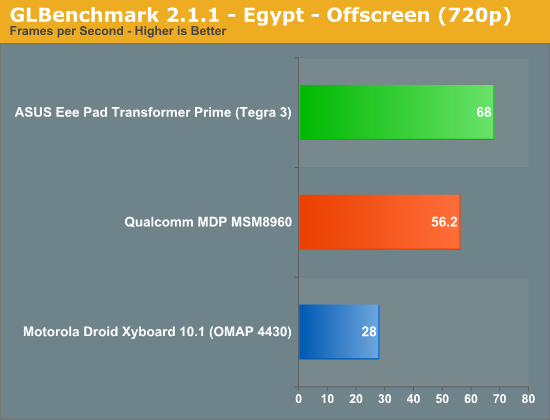
Qualcomm and NVIDIA swap places once again when we look at the older GLBenchmark Pro test, although both perform well thanks to the lighter nature of this test.
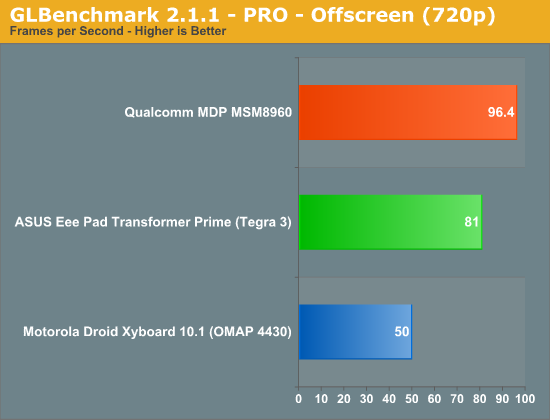
Basemark ES 2.0 is completely dominated by Adreno however:
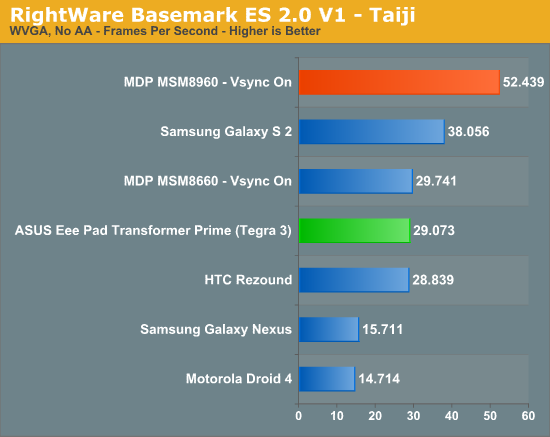
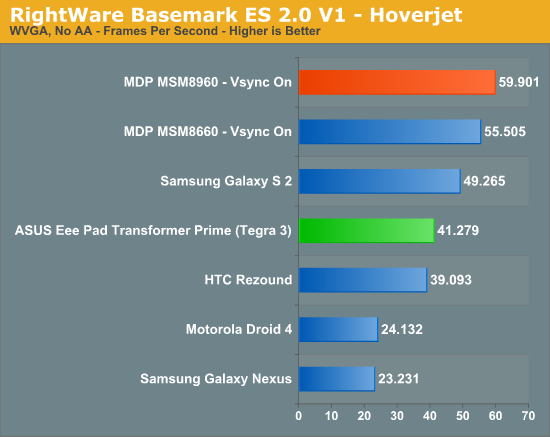
I'm still not totally sure why Basemark favors Adreno architectures so much but the results are what they are.
We've also been playing with Electopia, another Qualcomm-friendly test:
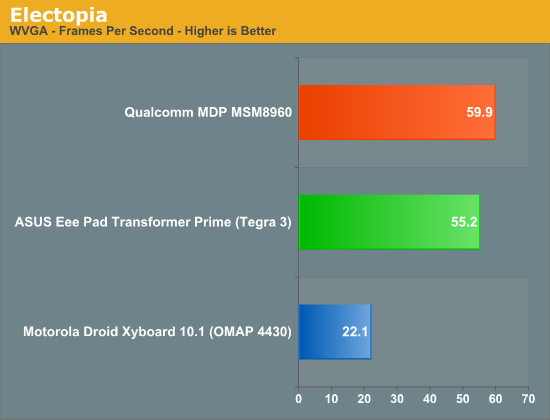
We do bump into Vsync limits with both the Tegra 3 and Qualcomm MDP at 800 x 480. Unfortunately Electopia doesn't allow for custom display resolutions, the only options are WVGA or native. The MDP has a native resolution of 1024 x 600 compared to the TF Prime's 1280 x 800 making a comparison at native resolutions unfair. That being said, according to Qualcomm the MSM8960 should be able to deliver around 40 fps at 1280 x 720 compared to the 24.6 fps we measured on the Transformer Prime at 1280 x 800.
Although Electopia is a game, it's still tough to tell how killer 3D titles on Android will end up performing. Oh the things I would do for an Unreal Engine 3 benchmark on Android...










49 Comments
View All Comments
wimbet - Thursday, February 23, 2012 - link
Thanks for posting comparisons with Tegra 3. It will be real interesting to see how OMAP4470 and Exynos4412 match up. I have a feeling we will see a lot more of OMAP5 and Exynos5250 at MWC as well.AmdInside - Thursday, February 23, 2012 - link
When are Krait 4 phones due? Still a while before my plan expires but just curious.infra_red_dude - Thursday, February 23, 2012 - link
Apparently MWC will see the launch of MSM8960 consumer devices.douglaswilliams - Thursday, February 23, 2012 - link
"I do hope the device vendors do these SoCs justice.""Will Moore's Law, and the 28nm LP process in particular, be enough to offset the power consumption of a higher performance Krait core under full load? Depending on how conservative device makers choose to build their power profiles we may get varying answers to this question."
Anand, perhaps some justice could lie in allowing user selectable power profiles, as on laptops. Let the user jump to a performance profile while playing a game or plugged in. Is that a possibility? Or will they just attempt to do that automatically in their stock power profile?
Wishmaster89 - Thursday, February 23, 2012 - link
Asus already did something like that with transformer prime so there's a possibility that with Krait powered padfone they could do the same thing. And don't forget that up till now Asus was quite good when it came to optimized software. So I have high hopes for Krait based Asus padfone with LTE radio.Perfect when connected to the tablet docking station.
Pipperox - Thursday, February 23, 2012 - link
It already happens, sort of.Any CPU governor will lower the CPU clock for light workloads, and max it out for games.
It's for the intermediate situations where you can see a big difference.
Anyway, this will be used on Android phones.
Hence, it'll be rooted in the blink of an eye, and custom kernels will offer multiple choices to the users concerning governors, so battery or performance optimized profiles.
ratn9ne - Thursday, February 23, 2012 - link
At&T doesn't even sell the galaxy nexus yet... so I expect this to be out sometime 2015.Loki726 - Thursday, February 23, 2012 - link
Anand,Can you comment on the Tegra 3 perf difference on sunspider in this review compared to your previous transformer prime review? This figure shows a score of 2300, and the previous figure in the transformer prime review shows a score of 1600. That's a pretty significant difference. Is there some change in the configuration that can explain this?
I saw that you mentioned a regression going from honeycomb to icecream sandwich, but then
you say that you included the faster honeycomb results.
Thanks
rahvin - Friday, February 24, 2012 - link
Without looking at the previous review, this review was clear that the Transformer had recently been upgraded to ICS. For those of you that haven't used ICS yet, it's significantly faster than Gingerbread on the same hardware.Gideon - Thursday, February 23, 2012 - link
"Oh the things I would do for an Unreal Engine 3 benchmark on Android..."Second that !
I don't think I have seen a single review/preview of a phone on Anandtech for the last year that doesn't include the same message. Hopefully the devs will finally notice.